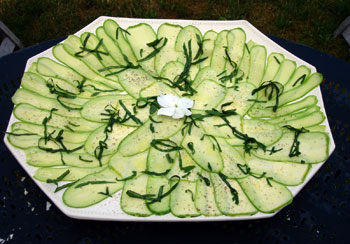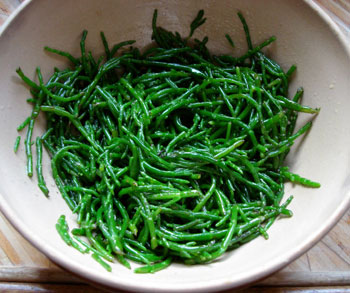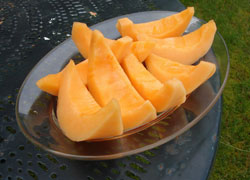 We eat a lot of salads at La Touche, my father’s country house in the Loire which he shares with a couple of long time friends. Lunch typically consists of several salads, a panier of bread, and a substantial wedge of cheese. It is a meal large enough to satiate an afternoon hunger but is not overly filling because there is rarely meat served unless it is reheated from the night before. A main reason for the plethora of salads is the summer surplus of garden produce including the aforementioned courgettes de nice, tomatoes, potatoes, and haricots verts.
We eat a lot of salads at La Touche, my father’s country house in the Loire which he shares with a couple of long time friends. Lunch typically consists of several salads, a panier of bread, and a substantial wedge of cheese. It is a meal large enough to satiate an afternoon hunger but is not overly filling because there is rarely meat served unless it is reheated from the night before. A main reason for the plethora of salads is the summer surplus of garden produce including the aforementioned courgettes de nice, tomatoes, potatoes, and haricots verts.
I wanted to do something creative with courgettes, the amazing little light green zucchinis, so I decided to make a carpaccio. Our kitchen is equipped with tons of culinary gadgets and the professional mandolin is one such toy perfect for cutting long translucent slices of zucchini. I arranged the slices on a large platter and dressed them a half hour before sitting down to lunch with lemon juice, olive oil, and sea salt. The brief marinating time gives the acidity in the sauce enough time to slightly breakdown the fibrous cells of the vegetable. I topped the zucchini with some shredded basil, a crack of black pepper, and a white impatient to dress up the presentation before we tucked in.
 These little green strings look like haricots verts at first glance but they are far from their terrestrial cousins. These are in fact salicorns or samphire in English, an aquatic succulent that is very tasty whether raw or cooked. They are basically string beans of the sea which are a delicacy in France though they are beginning to be eaten with increasing frequency in England. In an interesting historical and linguistic note the term samphire is believed to be a British corruption, or bastardization depending on whom you ask, of the French name for the plant, herbe de Saint-Pierre. I have always eaten them steamed or boiled and coated in sweet butter or olive oil as a scrumptious accompaniment to seafood. Because salicorns are cultivated mainly in salt marshes they have a very high salt content and must be cooked without salt in plenty of water. It looks a lot like seaweed when cooked but does not really taste like the sea besides being salty. In fact the flavor is more akin to baby spinach, green beans, or asparagus. These are a very tasty vegetable indeed, one of the rare foods that I eat solely when I come to France highlighting the richness and variety of French cuisine that I find so intriguing.
These little green strings look like haricots verts at first glance but they are far from their terrestrial cousins. These are in fact salicorns or samphire in English, an aquatic succulent that is very tasty whether raw or cooked. They are basically string beans of the sea which are a delicacy in France though they are beginning to be eaten with increasing frequency in England. In an interesting historical and linguistic note the term samphire is believed to be a British corruption, or bastardization depending on whom you ask, of the French name for the plant, herbe de Saint-Pierre. I have always eaten them steamed or boiled and coated in sweet butter or olive oil as a scrumptious accompaniment to seafood. Because salicorns are cultivated mainly in salt marshes they have a very high salt content and must be cooked without salt in plenty of water. It looks a lot like seaweed when cooked but does not really taste like the sea besides being salty. In fact the flavor is more akin to baby spinach, green beans, or asparagus. These are a very tasty vegetable indeed, one of the rare foods that I eat solely when I come to France highlighting the richness and variety of French cuisine that I find so intriguing.
 The third dish we had for our Sunday lunch on the patio along with a delicious piece of Comte and a creamy wedge of Roquefort was sliced melon served au nature without any preparation. The French love a good melon and even though these French table melons look like cantaloupe, they are most certainly not. They actually taste nothing like cantaloupe, often served with ham, prosciutto, or with aged port poured into the cavity of a halved melon. Originally cantaloupe referred only to lightly ribbed gray-green European melons like these though it has gradually come to connote any orange-fleshed melon. They are a bit smaller than American cantaloupes and are eaten as a savory rather than sweet treat even though they are sweeter than their US counterparts. Anyway you slice it however a melon is a melon and these are incredibly popular in France and are particularly delicious in the summertime. I like mine with a generous crack of black pepper which creates an interesting dynamic between sweet and spice, a very tasty and refreshing lunch item to enjoy when dining outside in the sunshine.
The third dish we had for our Sunday lunch on the patio along with a delicious piece of Comte and a creamy wedge of Roquefort was sliced melon served au nature without any preparation. The French love a good melon and even though these French table melons look like cantaloupe, they are most certainly not. They actually taste nothing like cantaloupe, often served with ham, prosciutto, or with aged port poured into the cavity of a halved melon. Originally cantaloupe referred only to lightly ribbed gray-green European melons like these though it has gradually come to connote any orange-fleshed melon. They are a bit smaller than American cantaloupes and are eaten as a savory rather than sweet treat even though they are sweeter than their US counterparts. Anyway you slice it however a melon is a melon and these are incredibly popular in France and are particularly delicious in the summertime. I like mine with a generous crack of black pepper which creates an interesting dynamic between sweet and spice, a very tasty and refreshing lunch item to enjoy when dining outside in the sunshine.
Also published on the food blog Pomander Saveur.

